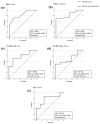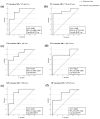New Perspectives for Low Muscle Mass Quantity/Quality Assessment in Probable Sarcopenic Older Adults: An Exploratory Analysis Study
- PMID: 38794734
- PMCID: PMC11123861
- DOI: 10.3390/nu16101496
New Perspectives for Low Muscle Mass Quantity/Quality Assessment in Probable Sarcopenic Older Adults: An Exploratory Analysis Study
Abstract
Background: Low muscle mass quantity/quality is needed to confirm sarcopenia diagnosis; however, no validated cut-off points exist. This study aimed to determine the diagnostic accuracy of sarcopenia through muscle mass quantity/quality parameters, using the bioimpedance analysis (BIA), isokinetic, and ultrasound tools in probable sarcopenic community-dwelling older adults (≥60 years). Also, it aimed to suggest possible new cut-off points to confirm sarcopenia diagnosis.
Methods: A cross-sectional exploratory analysis study was performed with probable sarcopenic and non-sarcopenic older adults. BIA, isokinetic, and ultrasound parameters were evaluated. The protocol was registered on ClinicalTrials.gov (NCT05485402).
Results: A total of 50 individuals were included, 38 with probable sarcopenia (69.63 ± 4.14 years; 7 men and 31 women) and 12 non-sarcopenic (67.58 ± 4.54 years; 7 men and 5 women). The phase angle (cut-off: 5.10° men, p = 0.003; 4.95° women, p < 0.001), peak torque (cut-off: 66.75 Newtons-meters (N-m) men, p < 0.001; 48.35 N-m women, p < 0.001), total work (cut-off: 64.00 Joules (J) men, p = 0.007; 54.70 J women, p = 0.001), and mean power (cut-off: 87.8 Watts (W) men, p = 0.003; 48.95 W women, p = 0.008) in leg extension, as well as the the forearm muscle thickness (cut-off: 1.41 cm (cm) men, p = 0.017; 0.94 cm women, p = 0.041), had great diagnostic accuracy in both sexes.
Conclusions: The phase angle, peak torque, total work, and mean power in leg extension, as well as forearm muscle thickness, had great diagnostic accuracy in regard to sarcopenia, and the suggested cut-off points could lead to the confirmation of sarcopenia diagnosis, but more studies are needed to confirm this.
Keywords: bioelectrical impedance; isokinetic; muscle mass; older adults; sarcopenia; ultrasound.
Conflict of interest statement
The authors declare no conflicts of interest. The funders had no role in the design of the study; in the collection, analyses, or interpretation of data; in the writing of the manuscript; or in the decision to publish the results.
Figures






References
-
- Cruz-Jentoft A.J., Baeyens J.P., Bauer J.M., Boirie Y., Cederholm T., Landi F., Martin F.C., Michel J.P., Rolland Y., Schneider S.M., et al. Sarcopenia: European Consensus on Definition and Diagnosis: Report of the European Working Group on Sarcopenia in Older People. Age Ageing. 2010;39:412–423. doi: 10.1093/AGEING/AFQ034. - DOI - PMC - PubMed
-
- Fernandes L.V., Paiva A.E.G., Silva A.C.B., de Castro I.C., Santiago A.F., de Oliveira E.P., Porto L.C.J. Prevalence of Sarcopenia According to EWGSOP1 and EWGSOP2 in Older Adults and Their Associations with Unfavorable Health Outcomes: A Systematic Review. Aging Clin. Exp. Res. 2022;34:505–514. doi: 10.1007/S40520-021-01951-7. - DOI - PubMed
-
- Vellas B., Fielding R.A., Bens C., Bernabei R., Cawthon P.M., Cederholm T., Cruz-Jentoft A.J., Del Signore S., Donahue S., Morley J., et al. Implications of ICD-10 for Sarcopenia Clinical Practice and Clinical Trials: Report by the International Conference on Frailty and Sarcopenia Research Task Force. J. Frailty Aging. 2018;7:2–9. doi: 10.14283/JFA.2017.30. - DOI - PubMed
MeSH terms
Associated data
Grants and funding
- PID2019-105164RB-I00/Ministerio de Ciencia, Innovación y Universidades
- 2021-SGR-00817/Agència de Gestió d'Ajuts Universitaris i de Recerca
- 2022 FI_B2 00011/Secretaria d'Universitats i Recerca del Departament d'Empresa i Coneixement de la Generalitat de Catalunya, the European Union (UE) and the European Social Fund (ESF)
LinkOut - more resources
Full Text Sources
Medical

